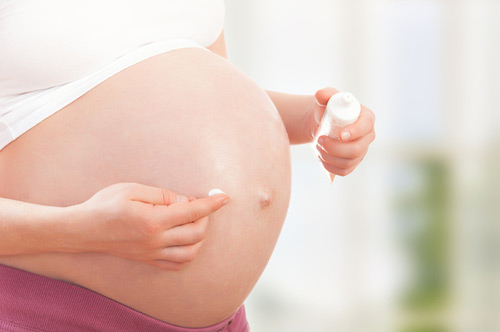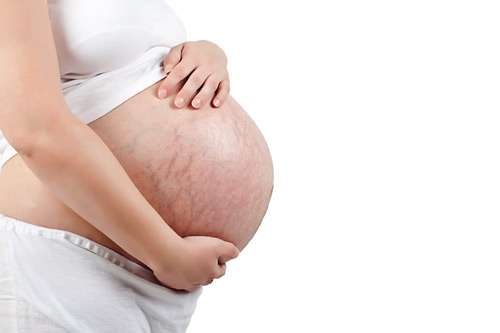Skin Issues
Some women may find that their skin has changed during pregnancy. Many of these changes are common and can be different from woman to woman.

Causes of Skin Changes During Pregnancy

Content Provided by March of Dimes
Changes in hormone levels during pregnancy can produce a wide range of skin changes, from stretch marks to acne to darkening of the skin. Most of these changes disappear shortly after delivery.
Types of Skin Changes
Acne
- During early pregnancy, some women develop acne, especially those who were prone to breakouts during menstrual periods before pregnancy.
- On the other hand, some women find that acne improves during pregnancy.
Bluish or blotchy legs
- For some women, especially those who live in cold climates, increased hormones can cause temporary discoloration or blotchy skin on the legs.
- This usually disappears after delivery.
Chloasma ("mask of pregnancy" or melasma)
- Some women have a brownish darkening of the facial skin.
- This change is called the "mask of pregnancy." It is more common in women with dark hair and pale skin.
- The woman usually has brownish, uneven marks on the forehead, temples and middle of her face.
- Sometimes the marks appear around the eyes or over the nose.
- The darkened areas may get even darker when exposed to sunlight.
- These marks usually fade completely after delivery.
"Glowing" skin
- Blood flow increases during pregnancy, including in the tiny vessels just beneath the surface of your skin.
- Pregnancy hormones cause skin glands to release oil. This may leave your face shiny.
- The result of these two factors may be a healthy "glow."
Itchiness
- Many pregnant women have itchy skin, particularly around the belly and breasts during the second and third trimesters.
- This happens as the skin stretches to adapt to your body's growth.
Linea nigre (dark line on the belly)
- For many women, extra pigment (coloring) in the skin causes a dark line to appear, running from the navel to the pubic area.
- This line fades after delivery.
Nails
- For some women, pregnancy hormones may cause changes in fingernails and toenails.
- These changes include faster nail growth than usual or nails becoming brittle or soft.
Puffiness
- During the third trimester, your eyelids and face may become puffy, usually in the morning.
- This is because of increased blood circulation. This condition is harmless.
- But if you have puffiness along with a sudden weight increase, contact your health care provider to rule out other potential problems.
Rashes
- Many women sweat more during pregnancy because hormones affect the sweat glands. This can increase the chances of getting heat rashes.
- Late in pregnancy, some women also develop harmless but itchy red bumps on the belly.
- These can spread to the buttocks, arms and legs, causing discomfort.
Red or itchy palms
- Increases in the hormone estrogen may cause your palms to become red and itchy.
- For some women, this may also affect the soles of their feet.
- Like most skin changes that occur during pregnancy, the redness usually fades after delivery.
Skin tags
- Skin tags are small, soft, flesh-colored growths or flaps that protrude from your skin.
- They usually form on the neck, breasts or armpits.
- They are most likely caused by hormonal changes. Skin tags do not go away on their own after delivery. A health care provider can easily remove them.

Stretch marks
- As the breasts and abdomen grow, most women develop stretch marks across the belly and breasts.
- These marks are small, depressed streaks of differently textured skin. They can be pink, reddish-brown or dark brown, depending on the woman's skin color.
- Some women also get them on their buttocks, thighs, hips or breasts.
- These marks are caused by tiny tears in the tissue that lies just below your skin and helps the skin stretch.
- There is no way to prevent stretch marks during pregnancy. They usually fade and become less noticeable after delivery.
- You may see creams to treat stretch marks in the drug store. It isn't clear whether these creams work.
Spider veins
- Some pregnant women have spider veins on the face, neck, upper chest or arms.
- These small, red spots have lines branching out from them.
- Spider veins are tiny blood vessels that appear because of increased blood circulation. Hormonal changes may cause them.
- These marks disappear or fade after delivery.
Skin darkening
- In most pregnant women, hormonal changes cause darkening of skin that is already darker than the rest of the woman's skin.
- This darkening may be most obvious in freckles, moles, areolas (colored rings around the breast nipples), nipples, labia (the genital tissue outside of the vagina) and the inner thighs.
- Some of this darkening may fade after delivery. But these areas are likely to remain darker than they were before pregnancy.
What You Can Do
Many skin changes during pregnancy are unavoidable and most disappear on their own after delivery. These tips may help reduce or treat common skin problems that occur during pregnancy:
Skin cleansing
- Good skin cleansing is the best way to avoid or treat acne breakouts.
- Wash your face with a mild cleanser two or three times a day.
- Don't wash too often or your skin may become dry, which can aggravate skin changes.
Sun protection
- Your skin is more sensitive during pregnancy. Good sun protection is very important at this time.
- Sunlight can darken pigment changes in your skin and increase your chances of getting "mask of pregnancy."
- Use a good sun block, cover up, and wear a hat when outside.
- Avoid spending time outdoors when the sun is strongest (between 10 a.m. and 2 p.m.).
Make-up
- Cover-up and foundation can help hide dark streaks or spots on the skin.
- Avoid makeup that contains mercury. Look at the label to see if the makeup contains mercury.
Stretch marks
- You won't be able to avoid stretch marks entirely.
- It will help if you gain only the recommended amount of weight for your size (usually 25 to 35 pounds), and do so slowly.
Moisturizers
- Moisturize your belly and your breasts to reduce itchiness and dry skin.
- To avoid skin irritation, use unscented moisturizer.
- Use mild soap when washing.
- Avoid hot showers or baths. They can dry the skin.
Excessive Heat
- Heat can intensify itchiness and rashes.
- When you go out in warm weather, wear loose-fitting, cotton clothing.
Hair
Three months after delivery, a lot of women lose hair on their head. This shedding is called telogen effluvium, but often it will grow back. It should, however, be followed by a dermatologist to make sure there is complete regrowth. Hirsutism, which occurs when women grow hair in typical male spots such as the lip and chin, can be triggered by the hormonal changes of pregnancy. It is not too severe most of the time and it's also not permanent and tends to disappear within six months of delivery.
Existing Skin Conditions
Skin tags or benign hanging things around the neck are hormonally related and tend to increase in number during pregnancy. Skin tags increase in numbers, moles can change color slightly and so can benign tumors, scars can become noticeable -- all because the high levels of estrogen have some effect on these tissues. They may go away or change back after delivery. Pregnant women with certain skin diseases are more likely to experience an aggravation, or less often, an improvement in their condition. For example, women with atopic dermatitis, a skin disease causing itchy, irritating skin lesions, may experience a worsening during pregnancy. In some cases, atopic dermatitis may develop for the first time during pregnancy. Psoriasis, a skin condition marked by raised, thickened patches of red skin covered with silvery-white scales, may improve during pregnancy. This improvement may be attributed to the high levels of interleukin-10 in pregnancy, a protein that is released by one cell to regulate the function of another.
Post Delivery Applications
An episiotomy is an incision performed between the vagina and the rectum that is used to increase the opening of the vagina to assist in delivery of a baby. The usual cut (incision) for an episiotomy goes straight down and typically does not involve the muscles around the rectum or the rectum itself. An episiotomy can decrease the amount of pushing the mother must do during delivery. It can also decrease trauma to the vaginal tissues and expedite delivery of the baby when delivery is necessary quickly. The repair is straightforward and is fairly simple to perform. The incision is repaired by suturing (sewing) the wound together. Episiotomy can be associated with extensions or tears into the muscle of the rectum or even the rectum itself. Other complications include bleeding, infection, swelling and local pain. The typical healing time for an episiotomy is around 4 to 6 weeks depending on the size of the incision and the type of suture material used to close the wound. Epizyn could significantly decrease the time it takes for this wound to heal.
The obstetrical procedure known as Cesarian section is often spelled this way in the U.S. with just an "e" although the Roman emperor remains Caesar in America with an "ae". Also referred to as a C-section. No matter what, it is a procedure in which a baby, rather than being born vaginally, is surgically extracted (removed) from the uterus. As the name "Cesarian" suggests, this is not exactly a new procedure. It was done in ancient civilizations upon the death of a pregnant woman who was near full term in order to salvage the baby. Julius Caesar (or one of his predecessors) was born by this procedure. The term "section" in surgery refers to the division of tissue. What is being divided here is the abdominal wall of the mother as well as the wall of the uterus in order to extract the baby. Postsurgery, you can expect virtually the same suite of symptoms as you would experience in a vaginal delivery: afterpains as your uterus contracts (you may be given oxytocin to speed the process), bloody discharge (lochia), discomfort in the perineal area, fatigue, and breast engorgement. But the physical and emotional recovery from a cesarean takes longer than recovery from a vaginal birth. You can expect to spend around three to four days in the hospital, and at least four to six weeks at home before you feel back to normal. The site of your incision may be quite sore at first; as the pain subsides in a week or so, it may start to feel twitchy and then get annoyingly itchy and there will be pink and purple colors that end up fading. During this time, apply Epizyn as directed and the itchiness and healing time will both be significantly improved.
More than 90% of pregnant women will develop stretch marks in response to the pulling and stretching of underlying skin during pregnancy. Stretch marks are pink or purple bands in the stomach area and sometimes on breasts or thighs. Exercise and daily use of Epizyn can be used to prevent stretch marks from occurring, as it keeps the skin moist and promotes cell proliferation.
 PREGNANCY
PREGNANCY  GIVING BIRTH
GIVING BIRTH  BABY CARE
BABY CARE  HEALTH & SAFETY
HEALTH & SAFETY  FUN STUFF
FUN STUFF  FAMILY
FAMILY 